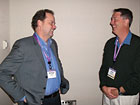
Johnstone
CEO DeWight Wallace, left, chats with John Thompson of San Bernadino, Calif.,
during Johnstone’s 2010 Annual Meeting in October in Chicago.
In an interview conducted during Johnstone’s 2010 Annual Meeting in October, Wallace noted the overall fiscal and structural strengths of the organization that has 125 owners and 350 branch locations.
“We are not changing the company,” he said. “We are not turning it around. We want to build on what we have in place and make it stronger. The time to invest is now when you have the resources - and others don’t. We want to take market share.”
THE ECONOMY
He described the current economic climate as having “cautious optimism,” citing a recent study of those in the HVACR industry saying “40 percent said they felt things will improve in the next 12 months.”He added, “We are not out of the woods yet. But we see signs of improvement. Johnstone is like all others in finding our way through this economy. I think there is pent up demand. New construction is still in a bad spot, but there is an install base where repairs are required.”
One component of that is federal stimulus legislation “which is helpful to us and our competitors. We are going to continue to work with Heating, Airconditioning and Refrigeration Distributors International and others to make sure such a stimulation package is beneficial to the industry.”
RECLAMATION
Wallace said the offering of reclamation services remains “value-added” for wholesalers. The system to bring recovered refrigerant back to ARI-700 purity standards has the backing of the U.S. Environmental Protection Agency (EPA) and refrigerant manufacturers but has not been used as much by contractors as both entities had hoped.Said Wallace, “Wholesalers are an extended partnership with contractors to help them. We provide many services like reclamation. Wholesalers are not just about having product.”
DRY-SHIP
At the time of the annual meeting, the issue of dry-shipping R-22 condensing units was just surfacing. Manufacturers, seeing a demand in the market for such components, began ramping up production in mid-year after the Air-Conditioning, Heating, and Refrigeration Institute (AHRI) and others had expected such production to cease as of Jan. 1, 2010 based on interpretations of the EPA ruling on R-22 component production.“Wholesalers are in a bit of tough spot,” Wallace said in noting it is currently legal to manufacture and sell such components, even though some sectors of the industry are raising concerns about that especially in terms of possible future legislation. “It is up to us to take the right inventory position … to have the product customers are asking for. That’s the value added we bring to the supply chain. We take control of the inventory (from a manufacturer) and we have it when the customer needs it. There is a bit of keeping a finger on the pulse of the industry and to what our customers are telling us. If laws change, we will change.”
MULTI-CHANNEL SERVICE
Throughout the annual meeting there was a focus on upgrades to data management and web platforms. Wallace said he hoped to have the new, more user-friendly website functioning by the organization’s spring meeting. At the same time, he said attention will remain high on contractors’ experiences at the supply house.He noted the importance of face-to-face contact at the counter and the ability of counter persons to help contractor customers. At the same time, the upgrades in the website and data acquisition are being designed for those who prefer those methods of doing business. And, in pulling both aspects together, Wallace said the new technologies will also help counter people do a better job in dealing with customers face-to-face.
He described the approach as multi-channel.
“There is going to be an infusion of younger talent into the industry. It is just going to happen. These are the guys right now who are texting their girlfriends. They are going to be up to speed on the new technology. If they are service technicians, they are going to come to the wholesaler and say, ‘What’s your website like?’ ”
“But there is also a customer base now that hasn’t cut their teeth on the new technology. And we are going to continue to service them.”
PLANS IN MOTION
Based on the new initiatives laid out at their annual meeting, Johnstone and their new CEO will have plenty on their plate as Wallace begins his second year at the helm.“Clearly we are moving on a lot of fronts at once, but I think this is a great time to make that effort,” he said, noting that Johnstone is pushing investments in customer service, training, and operational upgrades at a time when many companies are holding tight. “We expect all these efforts to pay exceptional returns as our industry evolves and the economic recovery builds.”
Publication date:12/06/2010


Report Abusive Comment